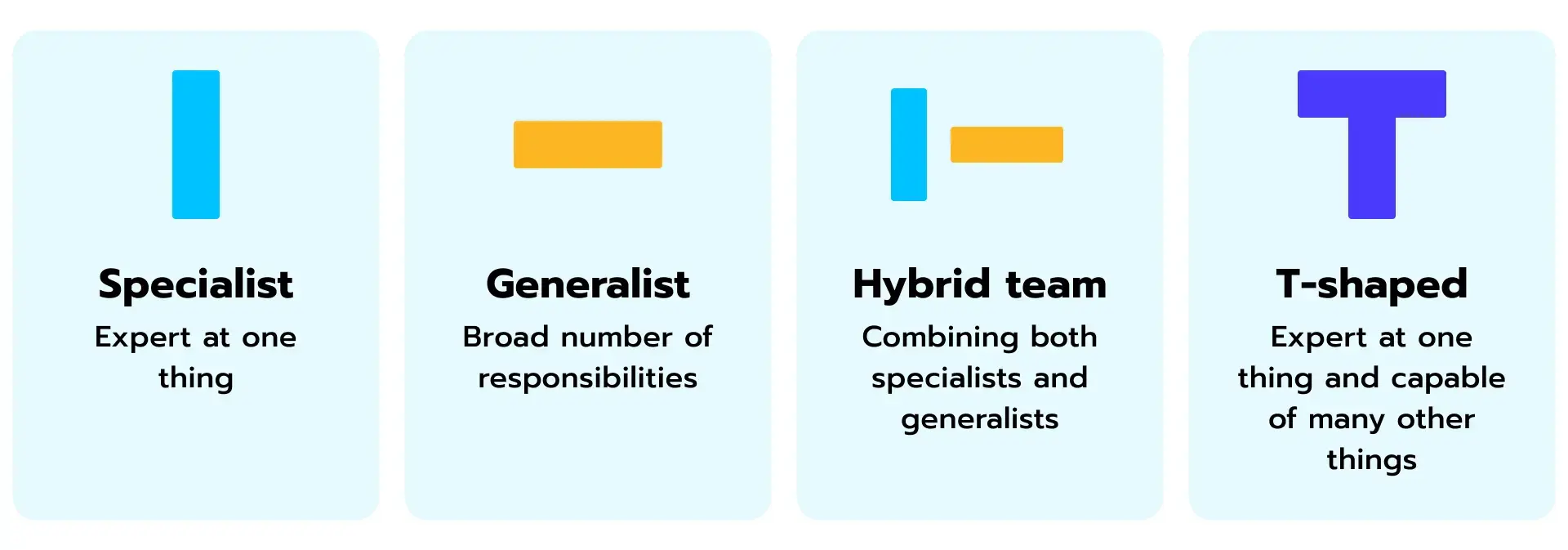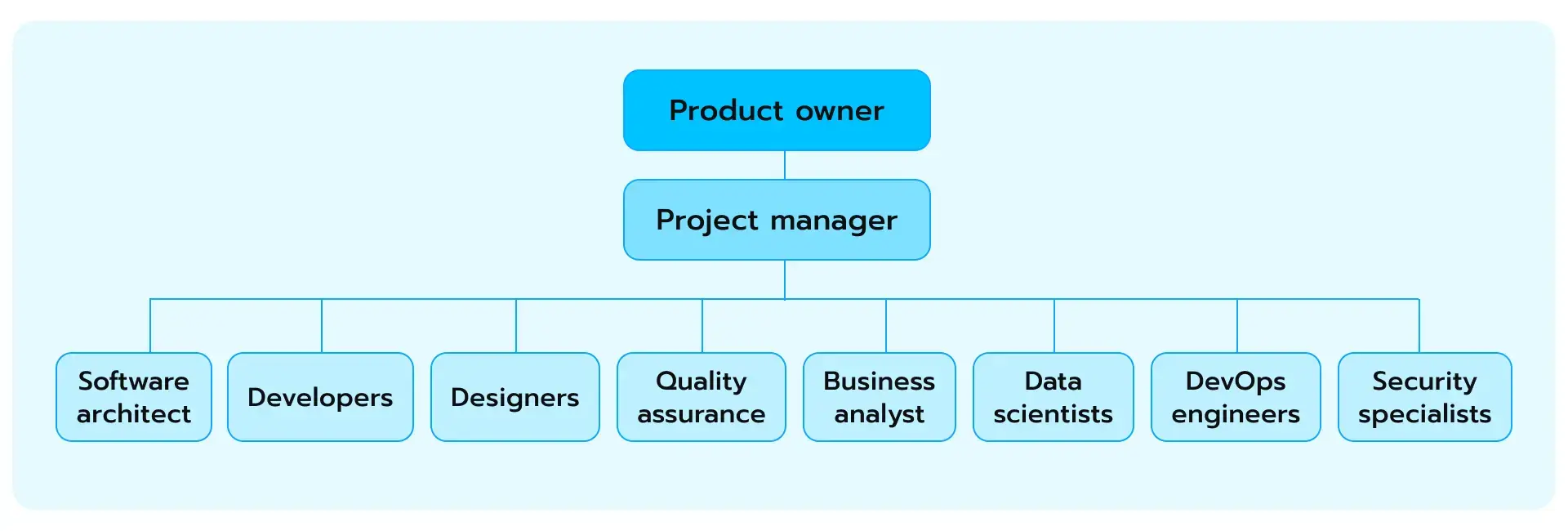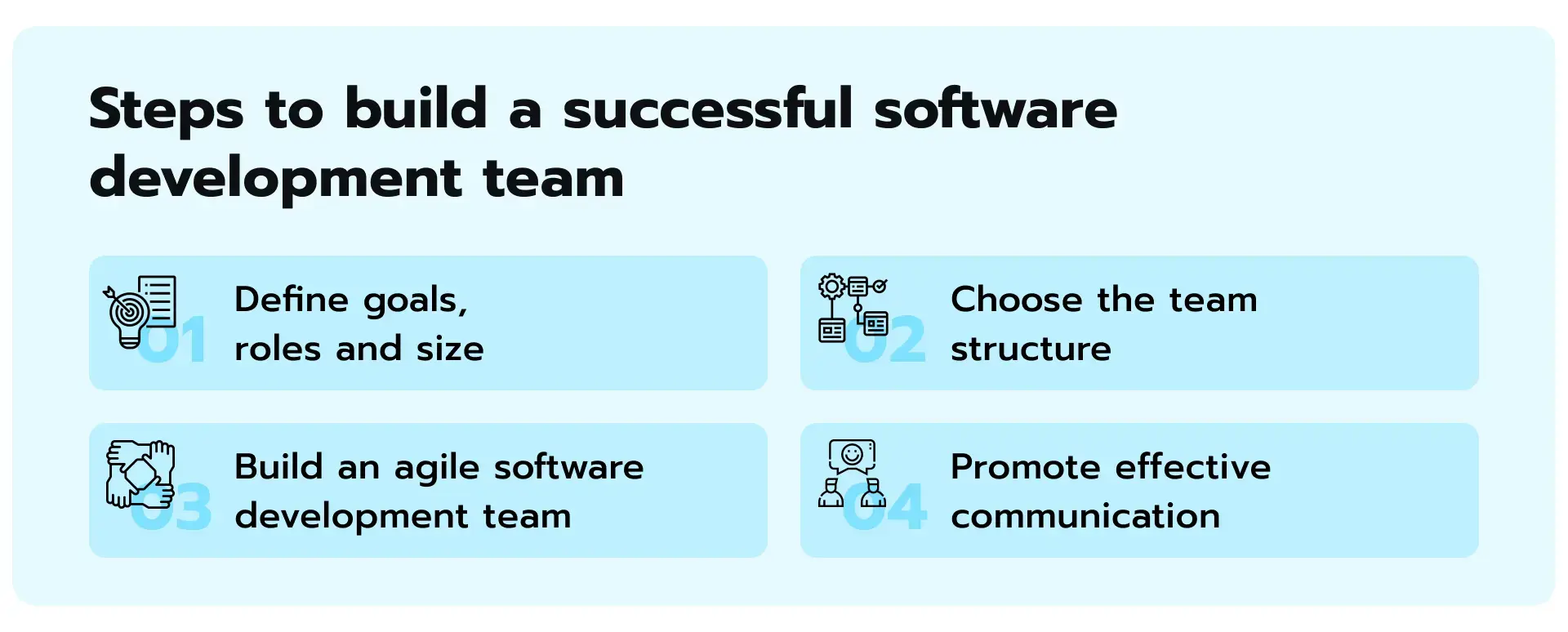Mastering the art of assembling a successful software development team.
When kicking off a new software development project, we naturally intend for it to succeed. But to make it successful, you have to rely on a solid core — your software development team.
One might get the impression that a successful development team must consist exclusively of highly experienced and skilled individuals. But is this the only prerequisite? In 2024, the landscape of software development has evolved, demanding a more nuanced approach to building an effective team. Below, we explore essential considerations for assembling one.
Define the kind of development team that fits your project
First things first, before we dive deeper into what to pay attention to when building a development team, you need to decide on the kind of team you want to create. Establishing a clear software development team structure is an essential first step toward the overall success of your project. Figure 1. Different team types.
Figure 1. Different team types.
Here, you have to choose from the main team types:
Generalists
The team members here have a broad range of skills, so they can adapt to various tasks. With the growing demand for cross-functional teams, generalists are increasingly valued for their ability to handle multiple aspects of projects. However, there are drawbacks. If your project requires a higher level of expertise in some area, generalists may lack the knowledge and skills.
Specialists
Unlike generalists, this development team comprises highly skilled members in a particular field. The advantage of specialists is clear — they can address a specific matter with all their knowledge and expertise, resulting in highly efficient and effective work. In 2024, for example, the rise of AI and machine learning has led to a higher demand for specialists in these areas. While specialists bring deep knowledge, integrating them into a broader team can be challenging. Sometimes, a very narrow specialist may lack a general understanding of the roles of other team members.
Hybrid team
As you’ve probably guessed, this type of team is a mix of the previous two. This approach combines the best of both worlds, where specialists focus on functional parts of software products, and generalists are responsible for communication and cooperation inside the team. However, this dream of a team also comes with a constraint. This software development team is typically very hard to assemble.
T-shaped professionals
This type of team is gradually becoming the preferred choice among various companies. A T-shaped professional is someone who excels in one specific area (the vertical line of the “T”) while also possessing a wide array of skills and knowledge across various disciplines (the horizontal line of the “T”). This unique blend enables T-shaped professionals to offer specialized expertise while effectively collaborating across different fields, making them invaluable assets in interdisciplinary teams.
Deciding which type of team to build depends on your project’s needs. Overall, it’s best to strike a balance between generalists and specialists or choose T-shaped professionals who are more flexible and can easily adapt to evolving project requirements.
An ideal software development team structure: how it looks like
Now that you’ve established what kind of team you want to build, let’s talk about the size. Smaller, agile teams are easier to manage, especially with effective project management. However, in this case, every team member plays a crucial role in the project, and losing even one person can significantly impact the overall results. With bigger teams, the challenge is in managing communication. In order to make sure that team members properly contribute to your development plan, it is also critical to assess their level of competence and their ability to work smoothly in alignment with your project needs.
When it comes to assembling the team, it all boils down to the following factors:
- Project complexity
- Budget
- Deadline
- Available resources
Having assessed these factors, you can decide on the appropriate team structure and size. According to the Scrum methodology within agile development, the optimal team size is between 3 and 9 members. If your software project requires a larger team, you’ll need to manage it effectively and establish proper communication channels.
Establish team roles and responsibilities
Now, this one seems obvious — the roles inside your engineering team are usually pretty straightforward. There are designers, developers, and probably a tester within the team, right? Yes, but no. In reality, the roles of an effective software development team are more versatile and complex than that. Moreover, in 2024, the roles have expanded to include new specialists, reflecting the evolving tech landscape. Figure 2. The general development team structure.
Figure 2. The general development team structure.
The overall structure of the development team can look like this:
- The product owner, in the case of an outsourced project, is the client with a vision of how the end product should look, who the end users are, and what it should do.
- A project manager is a person responsible for managing and leading the whole team. Their role is to optimize the team’s work efficiently, ensure the product meets the requirements, and identify the goals for the team.
- A software architect is a highly skilled software developer who has to think through all the aspects of the project and is responsible for making high-level design choices and selecting technical standards (for instance, determining the technology stack).
- Developers or product engineers are team members applying their engineering and programming language knowledge in the software development process.
- Experience designers ensure that the product is easy and pleasant to use. They conduct user interviews, market research, and design a product with end-users in mind.
- QA or tester is responsible for quality assurance and ensuring the product is ready.
- The business analyst’s role is to uncover ways to improve the product. They interact with stakeholders to understand their problems and needs and later document and analyze them to find a solution.
- Data scientists are now included by many teams to optimize algorithms and data models as AI and data-driven solutions become more integral to software projects.
- Security specialists ensure the software is secure and compliant with relevant regulations.
Understanding the roles within a software development team is crucial for the success of any project. Each role, from product owner to business analyst, plays a significant part in ensuring the project’s success, and the contribution of each specialist is vital for achieving the desired outcomes.
In the next section, we will delve into how an agile software development team is built. Agile methodology is a popular approach to software development that emphasizes flexibility, collaboration, and customer satisfaction. Let’s explore how to implement this methodology effectively in your team.
Build a successful agile software development team
The agile methodology makes your business analyst and team more flexible; it allows you to adapt and respond to unforeseen changes without damaging the whole process.
There isn’t a one-size-fits-all formula for building an agile team, but even within agile, you have two options: Scrum and Kanban.
The latter practices real-time communication and full work transparency. It relies significantly on visualization, which is at the core of this framework. Work is constantly visually represented on the Kanban board to help the team understand the current stage in the workflow. Using visualization, they can also work out their bottlenecks, what slows them down, and find ways to overcome challenges.
Scrum is the most popular agile framework in which an agile team breaks down a large project into smaller chunks (sprints) and reviews and adapts them. Sprints can last from a week to a month in duration. If you are adopting Scrum methodology, the structure of your software development team will include an essential element — Scrum master. These specialists ensure that the team sticks to the agile values and principles and follows the process that the team has agreed on.
Agile will help your team deliver faster and more efficiently regardless of the framework-building software you choose.  Figure 3. Steps to build an effective software development team.
Figure 3. Steps to build an effective software development team.
Learn more about how Avenga translated exclusive software engineering capabilities into a scalable and reliable software solution. Success story
Prioritizing communication
Communication is the final piece of the puzzle that often determines the success or failure of the software development team. You can have all the other elements on track and properly functioning, but if your team lacks this last element, it can harm your product and the whole development process.
If your team members can communicate their needs and project demands to one another, it can boost their collaboration and improve the work process overall. This can also help drive creativity and innovation inside the team. Good communication practices are important when discussing the project’s details and requirements with stakeholders, negotiating timelines, and generally trying to understand what the project needs to be successful.
Excellent communication skills are an essential soft skill for any software engineer. Your task is to nurture and encourage communication inside your software development team and make it a part of your everyday process by practicing daily stand-ups, designing and coding reviews, writing documentation, presentations, and social events.
Wrapping up
The success of your project starts with deciding what kind of software engineering team you want to build — whether it should consist of specialists with deep knowledge, a versatile group of generalists with some knowledge across various fields, or a mix of both. Then, you need to determine the size of your team. Once your team is organized, establish software development team roles and what is expected of each. But remember, a successful team has got to have clear communication channels and a practical work style.
In any case, it is always best to build teams with experienced software development providers. Contact us today, and we will help you gather a team of professionals who can handle projects of any complexity.


 Figure 1. Different team types.
Figure 1. Different team types. Figure 2. The general development team structure.
Figure 2. The general development team structure. Figure 3. Steps to build an effective software development team.
Figure 3. Steps to build an effective software development team.






